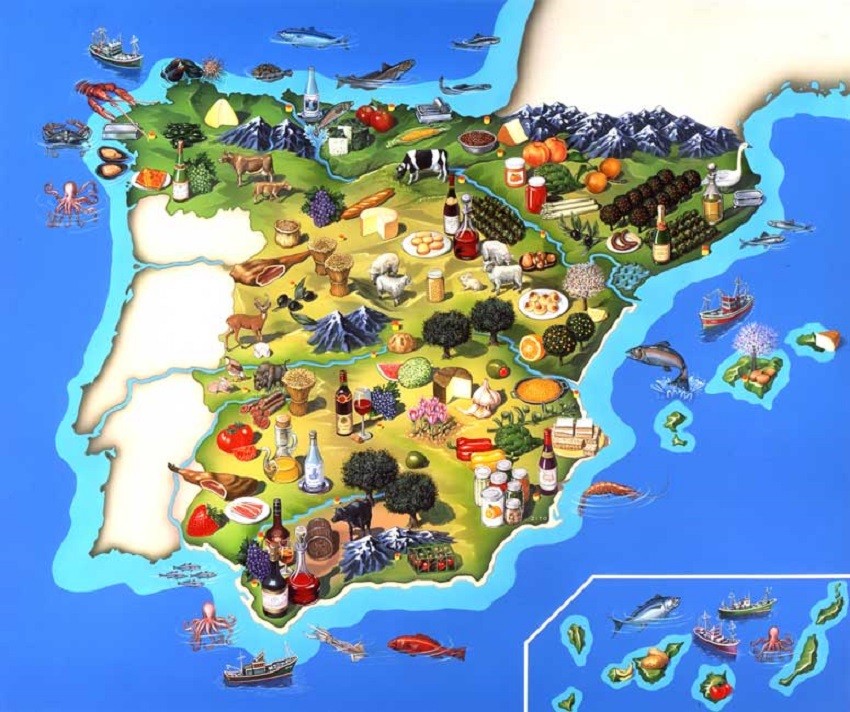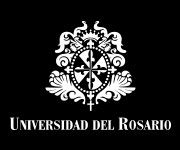
The Spanish cuisine is one of the best in the world for its quality and variety of products used, it is the pride of the country.
It is difficult to talk about the national cuisine of Spain as a whole. Rather, traditional cuisine consists of many regional cuisines. Each one influenced by the climate, history and customs of that region. However, you can distinguish common characteristicss in all Spanish cuisine. First, the Spanish cuisine itself is in fact quite simple. The base is onion, garlic and peppers. Usually it uses herbs, sage and olive oil. The simplicity and the quick preparation are also common in many regional recipes. Typical Iberian Peninsula cooking methods include stewing in wine, cookin with pecorino cheese or grilling or roasting.
Modern Spanish cooking is very varied, unique and impossible to recreate. It is influenced by the Romans, Moors and Americans.
Spanish cuisine is quite similar to the one of South France and Italy: the same Mediterranean blend of garlic, olive oil, tomatoes and green peppers, but still different with a clear influence from traditionally Eastern food. The arrival of the Arabs came with a variety of spices, almonds and rice - they essential components for many of the traditional dishes. South American cuisine has joined the American cuisine -as they went to Europe through Spain in the Middle Ages - such as peppers, tomatoes, potatoes, corn and chocolate.
Spain is divided into a large number of historical areas. Each of these has its own traditional cuisine, typical dishes and drinks. However, Spain can be divided into several large gastronomical areas.
North cuisine
In the north the main dishes are fish dishes. The Basque Country is famous for its cod with garlic. The cider and fabada represent Asturias. In Galicia the protagonist is the octopus. In Aragón people prefer to eat meat with spicy sauces. In La Rioja and Navarra they enjoy green sauces and particular garnishes.
Mediterranean cuisine
Mediterranean cuisine, combined with the famous Mediterranean diet, that has proved its health benefits, is based on the trinity of wheat, olives and vines. This is added to with ingredients such as rice, vegetables , garlic, herbs and other leafy vegetables, and then products like cheese, yoghurt, fish, meat, eggs and fruit. This rich and diverse cuisine has its own characteristic and different aspects in the different areas of the Spanish Mediterranean.
Central Spanish cuisine
The character of the cuisine of the central part of the country is mainly influenced by the harsh climate, the mountainous terrain and the heavy work. The base for this cuisine are green beans, lentils and various meats. One of the basic and typical dishes of the area are many variations on the theme of cocido (nutritious soup), along with other game dishes and cold cuts.
Andalusian cuisine
The cuisine of southern Spain is a fusion of cuisines from all cultures and villages that live in this fertile land. The famous gazpacho, which is a cold soup, was created here. All Andalusian sweet dishes and desserts are inherited from the ancient Moors.
Spanish cuisine is endless - it is impossible to try everything. However, in Spain, you must try and taste the traditional dishes - the famous Spanish omelette, spicy chorizo, ham, Andalusian gazpacho (Andalusia), octopus from Galicia, Segovian pork (Castilla y León), Asturian fabada (bean and pork stew), cocido (stew) from Madrid, potatoes typical from La Rioja, cod from Bizkaia (Basque Country), lobster stew (Isals Baleares), garlic soup (Castilla La Mancha) and of coursem, the paella (Valencia)
Tapas
This is an apperitif, served with beer or wine. In Spain there are special tapas bars where you can get many different dishes to share among a group of people. Some of the most popular dishes are olives and olives with lemon, patatas bravas, croquettes, squid, baby squid, cuttlefish, tuna, almonds, and a variety of sandwiches, for example in the popular bars in Madrid they eat a lot of fried squid and prawn sandwiches, or marinated pork, ham, black pudding, Spanish omelette, or cheese with olive oil. They alse use bread with garlic sauce (ali-oli in the Mediterranean) and garlic tomato bread (tumaca bread in the Mediterranean).
Salads
There are plenty of different salads, but there are three main types, the first beinig the lettuce based salad with tomato, onion, boiled egg and tuna (this is served overall in the Mediterranean coast). The second has a boiled potato base and can be served with peppers, tomatoes and onions, usually called "la ensalada campera" or "la ensalada payesa". The third is the "Russian salad" (ensalada rusa), which also has a potato base, with tuna, egg, carrots, beans and mayonnaise (unlike the other salads which are always dressed with olive oil and balsamic vinegar).
Soups
There are many hot and cold soups. The cold soups usually have a tomato base like the Andalusian gazpacho or the Cordoban salmorejo. Hot soups are usually a blend of vegetables or mushrooms with chicken or vegetable stock.
Fish and shellfish
Fish is the main component of the Mediterranean diet and one of the most popular dishes among the Spanish people. Many different species reside in the Spanish waters and one of the most popular is tuna. This fish is especially good when cooked immediately after being caught. In Spain tuna is cooked in many different ways; smoked, fried or tinned.
Skewered fish is fish that is cooked on a charcoal grill (especially sardines), coated with sea salt and well fried, and is a typical dish of Malaga Andalucía. Anchovies or "whitebait" can just be fried in olive oil or eaten raw with oil and vinegar. The anchovies are often served as tapas in a traditional Spanish restaurants.
Seafood is an integral part of Spanish cuisine. (Spain is second only to Japan, as the first country in the world that consumes the most fish and seafood). The Spanish love oysters, scallops, mussels, shrimp and other shellfish, which are used in all kinds of soups, sauces, paella, served as individual dishes or as tapas.
Ham
Uncooked dried Spanish ham is an exquisite Spanish delicacy. It is the national treasure and heritage of the country. "Jamón" is the basis of the Iberian cuisine. It is a leg of pork that has been salted and dried under strict defined conditions, which creates one of the most popular meat delicacies worldwide. It is a very low cholestrol food and widely used in the country. The most traditional Spanish ham can be seen in almost every bar and restaurant. They are hung from the roof, and secured onto a special machine in the bar. There are two main types of ham, Serrano ham and Iberican ham, often called pata negra. They differ in the way they are prepared, their cooking time, and the most significant difference is they breed and diet of the pig used. They can be visually distingushed by the colour of the hoof, Serrano is white and Iberican is black.
Rice
The most famous Spanish dish is of course paella. It is a rice dish that's cooked in a special way. There are many recipes for paella. Spaniards say there are more than three hundred. The classic paella, as well as rice, includes aroun 6-7 types of fish and seafood, chicken, white wine, herbs and spices. In some regions of Spain they also use beans in their paella.
Valencia is the main rice cultivating area in the country. Among the traditional dishes of the region you can find rice with tomatoes, beans, artichokes and other vegeatbles, in addition to black rice cooked with squid ink. You can find more information about rices and paella on the Valencian cuisine page.
Sweets and desserts
The most famous Spanish delicacy is probably el Turrón, a kind of nougat. Initially a Christmas treat, since tourists and locals both enjoy this delicacy it is sold throughout the year. It's production started with the arrival of the Arabs who lived in the Iberican Peninsula thousands of years ago. Much before the arrival of sugar sweet foods were made using honey. Nougat is traditionally made from high quality products such as honey, egg white and a variety of dried fruits and also chocolate. Polvorón which is a kind of light crumbly shortbread is a Christmas treat in Spain, which you will find on every table during the Spanish festivals and parties. Spanish people seem to think that the cookie is of Spanish origin without a Muslim influence.
More popular dishes are various creams and flans. One of the favourite desserts is crema catalana, a kind of Spanish creme brulee made from egg yolks, sugar, milk, lemon rind, and cinnamon.
Among the famous desserts of the Canary Islands you will find almond cream and milk pudding.
In Navarra they eat rice pudding, which is like a thick porridge sprinkled with cinnamon powder.
In the Vasco country the most popular fruit is the apple and it is found in many desserts such as baked apples stuffed with nuts and dried fruits, apples with vanilla ice cream, apple cake and apple tarts.
In Valencia and Murcia the desserts are more citrus based with orangle slices in orange liquer or orange flan.
The city of Ávila is famous for its special dessert - las yemas de Santa Teresa, a pastry dessert made of egg yolks, sugar and water.
When talking about Galicia's desserts you can't forget the glazed chestnuts.
And finally ,known for it's famous wine, La Rioja is also famous for its sweet dishes. For example, pears in red wine, melons in wine and a wine sorbet.
Alcohiloc drinks (for those 18 and over)
Jerez is the wine made in Spain and got it's name from the city of Jerez de la Frontera. It's good on it's own and in cocktails and goes well with vodka, whiskey, and gin. Cocktails with this wine are the perfect appertif!
Wine is the most common Spanish drink and has been an essential part of all regional cooking since Roman times when they spread the art of winemaking in the Pyrenees. Nowadays together with France and Italy, Spain is one of the three major wine proudcers in the world. In the 60 wine regions of Spain there are around 90 varieties of grapes.
Sangria is a traditional Spanish drink and it's name comes from it's blood red colour - sangre (blood) becomes sangria. It is a mixture of dry red wine, that's sweetened and spiced and with the addition of various citrus fruits. It's usually served in a jug or a wide glass with ice.
The cider here is produced in Asturias (northern Spain). It comes in two varieties: natural and frothy. Natural cider is dry, with a higher alcohol content of 5-6%. The second type is a less dry fizzy drink with added sugar.
The Spanish drink a lot less beer than the Germans or Czechs but recently the sales of this drink have increased massively. In Spain the only beer is light beer. One of the most popular in Madrid is Mahou, in Malaga San Miguel, inSevilla there is Cruzcampo, and in in Granada they have Alhambra. When ordering beer you can choose from several amounts, a caña (a small portion of 5oz), a double which is twice as big, a tanque (a half litre), a pitcher (a litre, normally shared).
Tea and coffee
In Spain it is customary to drink tea, usually referred to as an infusion, unless you are in an Arab tea house then you ask for tea. Coffee is served in Spanish bars, cafeterias, and restaurants in a variety of ways, cafe solo is an espressosmall black coffee, café cortado is an espresso with a splash of milk, and cafe con leche is a bigger coffee with hot milk.






















